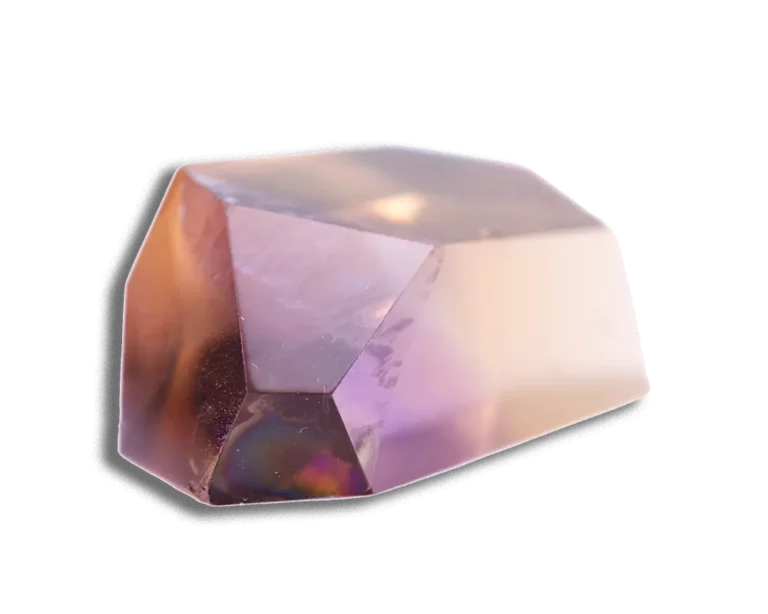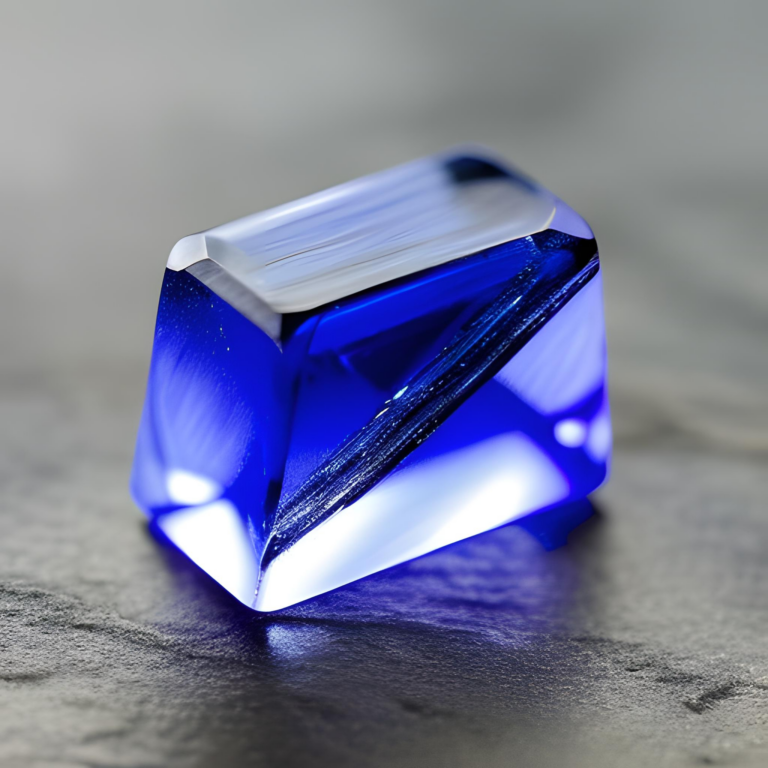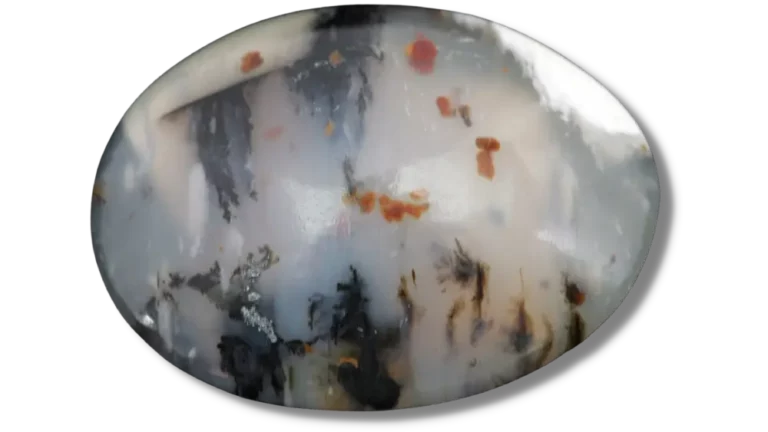Snowflake Obsidian: Properties, Benefits & Meanings
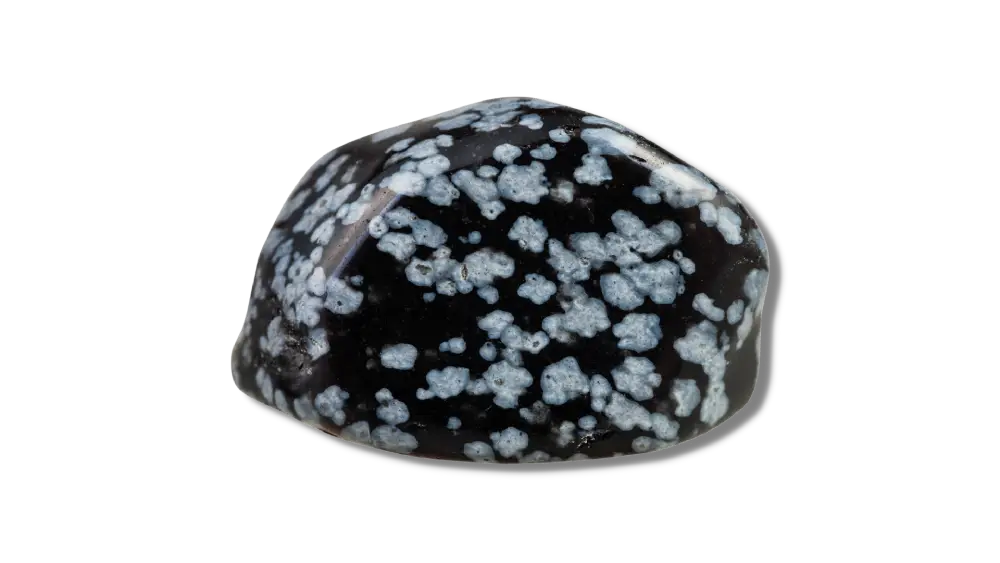
Snowflake Obsidian Overview
Snowflake obsidian is a unique volcanic glass that has been found in volcanoes throughout the world. It is a variety of Obsidian that has small white spots or patches that appear like snowflakes or a snowfield.
It is said to have powerful healing properties that help to cleanse the aura, balance chakras (energy centers), enhance psychic abilities and help you connect with your higher self.
This article will talk about the properties, meanings, and uses of Snowflake Obsidian.
What is Snowflake Obsidian?
Snowflake obsidian is a variety of Obsidian. It contains an eye-catching and intricate snowflake pattern that often appears on the surface of the stone, formed through rapid cooling.
It’s a rare stone that is pricier than other types of Obsidian. Its mostly found near volcanoes and its unique coloration comes from trace amounts of iron and titanium in the stone’s composition. These metals give snowflake Obsidian its unique look.
Snowflake obsidian, also known as The Stone of Purity, is connected to the root and third eye chakra. It is a popular metaphysical stone due to its alleged ability to bring clarity and balance to healing rituals. It is said to alleviate stress, bring calmness and tranquility, and help heal grief.
Etymology
Snowflake obsidian is named for its unique and beautiful inclusions, which give it a frosted appearance. The word “obsidian” comes from the Latin word “obsidius,” which means “sharp.”
The etymology of this word is a bit hazy, but it seems that it was initially thought to be related to the Greek word “odysseus,” which means “trouble.”
Other Names
- Flowering Obsidian
- Spherulitic Obsidian
Appearance
Snowflake obsidian is a variety of Obsidian. It is a unique gemstone that is mainly glossy black. Its distinguishing features include a white-to-gray color and the presence of tiny crystals that look like snowflakes. This type of Obsidian has been used as jewelry since ancient times and was popularized by Native Americans in North America.
The inclusions within the stone can be black or gray, with some pieces having cristobalite inclusions. Cristobalite, a polymorph of quartz, forms in spherulites.
These spherulites are small, round crystals forming slowly when molten lava cools. It is often embedded in the crystal structure of Obsidian and may improve the material’s toughness.
The slow cooling process allows for forming larger crystals, which are more resistant to breakage than smaller ones.
History of Snowflake Obsidian
Obsidian has been used since ancient times, but no Snowflake Obsidian has been found that dates before the Cretaceous period. It was first called “flowering obsidian” because of the flower-like patterns on its surface.
This stone has been used as far back as 9,000 BC in jewelry and was also used in ancient times for arrowheads and knives. Today it’s still popular for jewelry and home decor because of its colorful appearance and durability—Obsidian does not scratch easily and holds up well under heavy use.
How Is It Formed?
Snowflake Obsidian is a lovely, translucent stone with a delicate, snowflake-like pattern that forms in the stone during formation. It’s created in volcanic eruptions when lava cools rapidly, which causes the rock to form gas bubbles that become trapped inside the stone.
This stone ranges from transparent to translucent; it can be black or light gray.
Obsidian is formed when lava cools rapidly. The lava cools so fast that it doesn’t have time to crystallize, so Obsidian has a fine-grained appearance.
It is created in the Earth’s crust at depths of 10 to 50 kilometers below the surface, where high levels of pressure and temperatures are approaching those found at sea level.
Physical Properties
Snowflake obsidian is a form of volcanic glass composed of quartz and cristobalite. It has a white to gray color and a vitreous luster. It forms as lava cools extremely quickly, usually after being ejected from a volcano.
It has densities higher than most other types of natural glass (approximately 2.64 g/cm3). This obsidian is known for its triangle-shaped inclusions, which are called snowflakes because of their resemblance to frozen water crystals.
This stone is known for its iridescent appearance, which comes from internal cracks in the glass that refract light. It has a fine-grained texture similar to basalt.
| Mineral Group | Siliceous Glass |
| Formula | SiO2, other trace elements |
| Color | Black with white inclusions |
| Hardness (Mohs scale) | 5 – 5.5 |
| Refractive Index | 1.48 – 1.51 |
| Fracture | Conchoidal |
| Luster | Vitreous |
| Specific Gravity | 2.3 – 2.6 |
| Transparency | Translucent, Opaque |
Where Can You Find Snowflake Obsidian?
Snowflake obsidian is found in volcanic regions. It is primarily found in:
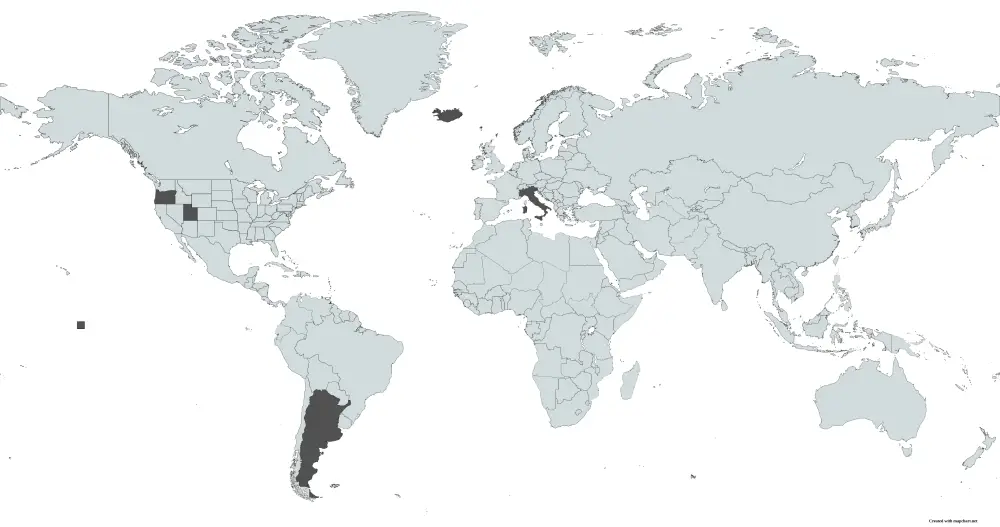
How To Tell If A Snowflake Obsidian Is Real?
Authentic snowflake obsidian has several features that set it apart from artificial stones.
Glassy: To tell if it is real, you will want to look for a glassy shine. Snowflake obsidian has a natural roughness that gives it an iridescent sheen. If the surface is glossy and reflects a lot of light, then it’s naturally occurring.
Scratch test: Genuine Obsidian has a hardness of 5 to 5.5 on the Mohs scale. This means that it can easily be scratched by a glass or fingernail. However, it may not be marked by a softer material, such as talc or Blue Flourite.
Pattern: The snowflake pattern on a synthetic stone will be too uniform or perfect. A naturally occurring obsidian will have natural imperfections and different-sized patches of white.
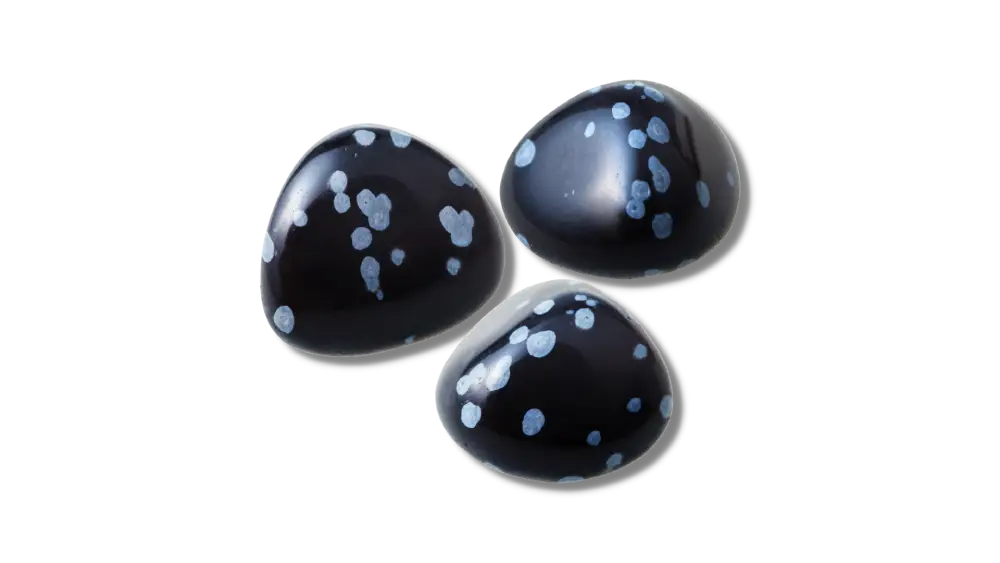
Value & Price
Snowflake Obsidian is a natural obsidian that has been cut, polished, and shaped into various shapes. The material comes in many colors and can be used as an ornamental stone or as a gemstone.
Obsidian is an affordable gemstone. The value of this Obsidian depends on its size, color, quality, and cut. The price per piece can range anywhere from $5 to $20, depending on these factors.
Quality: The most desirable specimens have a uniform color, with the crystals being evenly distributed throughout the stone. Gem-quality stones have higher clarity and are more reflective.
Size: Larger pieces tend to cost more than smaller ones.
Cut: this stone is trendy in jewelry, and it’s often used as beads or cabochons.
Snowflake obsidian is an inexpensive gemstone that makes excellent gifts for friends and family. It can be purchased online in small pieces for just a few dollars per piece or more significant amounts for less than $10 per piece at online stores such as Amazon or Etsy.
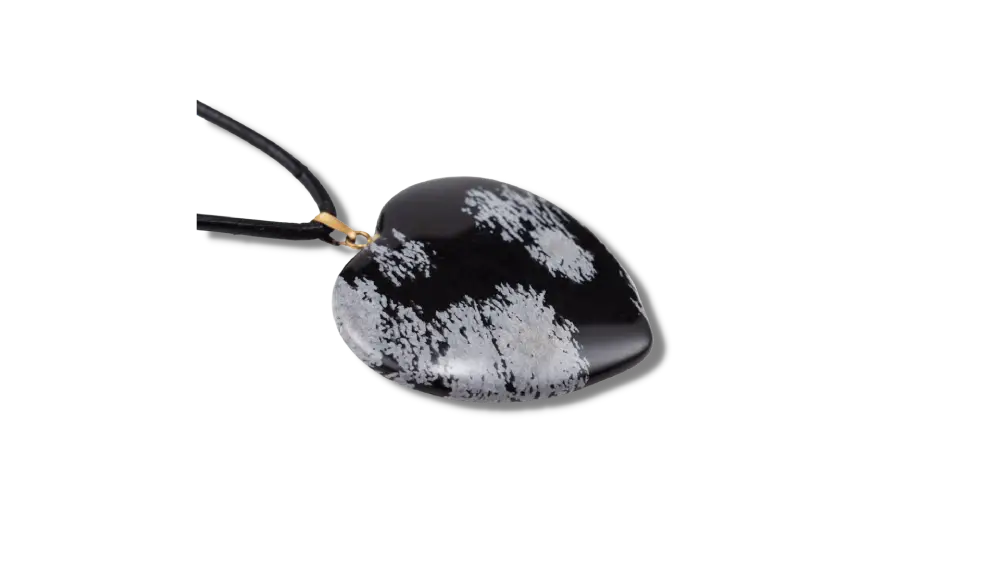
Chakra Connection
Snowflake obsidian is connected to both the root and third eye chakra.
The root chakra is the first to open, also called the “base” or “root.” It’s located at the base of your spine. When this chakra is blocked, one may feel insecure or afraid to grow as people because we are worried that we won’t have enough support from others to help us through life’s challenges.
Snowflake obsidian can help us become aware of what keeps us from feeling secure in our lives—and then it can help us start to unblock those things, so we can feel more grounded and connected to ourselves and those around us.
The second name for this Chakra is Sahasrara which means lotus flower. The Flower has four petals representing four functions: (mind), Buddhi (intellect), Chitta (consciousness), and Ahamkara (ego).
The third eye chakra is between your two eyebrows on each side of your face. This center for Clairvoyance and Psychic abilities is said to open when one fully matures.
Snowflake obsidian is one of the best stones to use when opening up your third eye chakras. It’s an excellent tool for helping you connect with your intuition and inner knowing, as well as helping you feel more relaxed and open-minded in general.
It is said that you can use this gemstone by laying it on your third eye chakra while meditating or placing it near your bed so that its energy can help you sleep better at night.
Metaphysical Properties
Snowflake obsidian is a beautiful stone, but it’s much more than that. It has been used as a powerful healing tool since ancient times to promote physical and spiritual balance. It is also considered a protective stone.
In terms of metaphysical properties, this obsidian is associated with cleansing and protection. It’s thought to be useful for healing people who have been hurt by others, and it’s also said to help you trust your own intuition more than ever before.
Additionally, it’s also believed that this stone can help you learn how to feel comfortable in your own skin by helping you accept your imperfections and embrace them as part of what makes you beautiful.
This gem is often used as an aid to meditation and introspection. It is said to help to clear away negative energy and thoughts, allowing one to see the world with fresh eyes. It is also believed to help with grief by helping you process your feelings and move through them.
Many say that this Obsidian works well as part of a full-body crystal grid system because it can be used alone or in combination with other stones to facilitate spiritual growth by raising consciousness levels and promoting positive intentions within its user’s life experiences.
Snowflake Obsidian Uses
Snowflake obsidian is a beautiful form of volcanic glass used for centuries in jewelry, art, and spiritual practices.
- The most well-known use for Snowflake Obsidian is jewelry. It is often used in necklaces and rings because of its unique beauty and durability.
- In ancient times, this obsidian was considered a stone of protection and healing because it was believed to have the power to ward off evil spirits.
- It was also believed to cure muscular aches and spasms.
- The stone is said to help those experiencing grief or loss find closure and be supportive during times of transition.
- In modern times, many people use Snowflake Obsidian for self-reflection, self-expression, and growth. This stone helps you identify your weaknesses, so you can work on them and grow.
- The stone is also used in many different types of knives, including hunting and kitchen knives.
- It was also used in ancient times as a material for mirrors.
- Snowflake Obsidian bracelets have been used in meditation, feng shui, and prayer since ancient times.
- This stone is valued for its beauty and uniqueness by worldwide collectors.

How To Take Care Of Snowflake Obsidian Jewelry?
The following is a list of ways to keep your stone clean:
- Use a soft cloth to wipe down the surface of your Snowflake Obsidian.
- Do not use abrasive or ultrasonic cleaners on this stone because they can damage it and make it look cloudy.
- Do not use steamers on this type of Obsidian, as they can cause cracks in its surface.
- Burn white sage or other cleansing materials to remove any leftover negative energy
- Recharge your stone by (bury in the ground, leave overnight during a full moon, pour salty water over it for a few minutes)
- Do not use hot water, steam cleaner, or ultrasonic cleaner. Do not wear jewelry during heavy exercise. Store it in a cool and dry place.
FAQs
Which Gemstones Go Best With Snowflake Obsidian?
Snowflake obsidian goes well with many gemstones. It is a beautiful, delicate stone that works well as part of a larger piece. It’s not great on its own, but it gives other gems a chance to shine.
Here are some of our favorite ways to incorporate snowflake Obsidian into your jewelry designs:
Pair it with other gemstones with interesting shapes or textures, like moonstones, pyrite, or labradorite.
Use it as an accent in a pendant that includes other gems—it’s especially lovely when paired with pearls, lapis lazuli, black Obsidian, or opal.
Try using it as the main focal point of a necklace or bracelet design—it can be worn alone, but it looks great paired with other gems like amethyst and blue lace agate.
What Is Snowflake Obsidian Good For?
Snowflake obsidian is a beautiful and unique type of volcanic glass that can be used in many ways. Jewelers and artisans mainly use it, but it also has a variety of other uses.
Jewelry: The most common use for snowflake Obsidian is as jewelry. The stone’s unique shape makes it ideal for creating pieces that have never been seen before.
Art: Snowflake Obsidian can also be used in art projects, including sculptures and mosaics. The stone’s natural beauty can be enhanced further with the addition of paint or other decoration techniques.
Meditation: Snowflake obsidian can be used for meditation due to its calming effect on the mind. This stone is said to help people focus their energy on inner peace instead of external distractions like noise pollution or technology addiction.
Energy healing: Snowflake obsidian can also be used as a healing tool because it helps balance emotions such as anger or hatred towards others who may have wronged us in some way during our lifetime.
Is Snowflake Obsidian rare?
Snowflake obsidian is an extremely rare variety of Obsidian, a naturally occurring volcanic glass. Snowflake obsidian can be found in a few places around the world, including Oregon, California, and Sri Lanka.
It can also be found in Mexico and Argentina. It’s rare because it’s not always easy to find large amounts of snowflake Obsidian at once; they are usually only found in small pieces or slabs.
Is Snowflake Obsidian porous?
Snowflake obsidian is not porous. Instead, snowflake obsidian is a type of volcanic glass called Obsidian formed when lava cools rapidly. The edges are often jagged, and the stone can be black, gray, or brown.
It’s important to note that this stone isn’t porous like other rocks like sandstone or marble—it doesn’t absorb water easily or allow air into its structure at all times (which means it won’t stain easily).
Can Snowflake Obsidian be synthesized in a lab?
Yes, snowflake obsidian can be synthesized in a lab. However, this process is very expensive and time-consuming. The main reason that snowflake Obsidian is so rare is that it takes millions of years to form naturally in the Earth’s crust.




